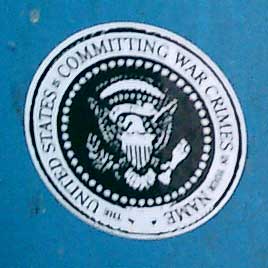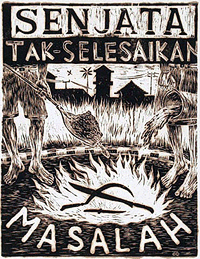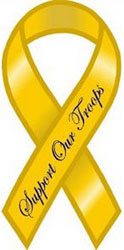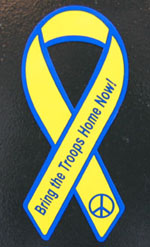war
Rock Around the Clock
In Phoenix, I stop for a burger with the family at the “Five and Diner.” The food is decent, but the decor is overwhelming — the place is a fully decked out in 1950’s retro style.
 Why the association of diners with a certain kind of 1950’s art deco style? You know, the glass block and formica, checkered vinyl floor, those aluminum stools and that jukebox full of upbeat, happy rock songs (with no swear words), walls decked out with posters of Elvis, James Dean, Marilyn, and Coca-Cola...
Why the association of diners with a certain kind of 1950’s art deco style? You know, the glass block and formica, checkered vinyl floor, those aluminum stools and that jukebox full of upbeat, happy rock songs (with no swear words), walls decked out with posters of Elvis, James Dean, Marilyn, and Coca-Cola...
Was it the new interstate highway system and manufacturing trends that put consumers on the road and brought machine-age styling to the lunch counter?
“It was a simpler time,” someone says. What, because post-war economic boom made such a happy middle-class? Or because G.I. bill paid your father’s college tuition and subsidized his mortgage? Was it all the white, middle-class families on TV? Or because it was before the end of segregation? Gay rights? The second wave of feminism? In fairness, though, as a kid maybe you were simpler.
But the Five and Diner is not some carefully preserved historic artifact. It is a fully contemporary invention, invested heavily in the myth of “the 50’s.” In fact, those “traditional family values” are a rather contemporary idea.
Art deco trappings and its Googie spawn were once signposts towards streamlined, technology-serviced future. The former was particularly embraced by European fascist states, the latter by an American suburban capitalism.
Now, both styles seem firmly lodged in the past. But they have not lost their utopian flavor — the futurism has been displaced by nostalgia.
In the U.S., at least, it’s become the visual, aesthetic, and user experience version of “comfort food.”
And adopted by the backlash.
Retool
Folks in Maine have a plan to fight the war by saving jobs — and the environment.
 Christie Toth reports in the April 1, Portland Phoenix about a statewide, grassroots campaign to convert Maine’s military manufacturing infrastructure to environmentally sustainable, non-military manufacturing:
Christie Toth reports in the April 1, Portland Phoenix about a statewide, grassroots campaign to convert Maine’s military manufacturing infrastructure to environmentally sustainable, non-military manufacturing:
“A year ago, Bath Iron Works, Maine’s largest private employer, had a contract to build seven DD(X) Destroyers for the United States Navy.
Now, the president’s budget proposal has slashed the destroyer order by more than half, and the Navy is considering giving the entire contract to a shipyard in Mississippi. As the Maine delegation fights what may be a losing battle on the Hill, economic conversion is beginning to look like more than an idealistic pipe dream. It is beginning to look necessary for Midcoast Maine’s economic survival.
With more than 6200 employees, BIW is Maine’s largest private employer; however, despite a robust shipbuilding schedule, the yard has been hemorrhaging jobs for years. Over the last six months, with 51 layoffs here, another 137 there, BIW has eliminated nearly 500 positions. And those layoffs barely register compared to what the company, a subsidiary of the Virginia-based General Dynamics Corporation, may be facing in the near future....
The Maine congressional delegation is doing everything in its power to push against the carrier-like momentum of Donald Rumsfeld’s vision for leaner, meaner armed forces. Senators Snowe and Collins warn of the grave dangers of single-source destroyer construction in Mississippi, citing everything from terrorist attacks to hurricanes. Congressman Tom Allen rails about the costs of the Iraq war, which he says could purchase a destroyer a week. None of Maine’s elected representatives has been above a little fear-mongering about China....
Peace Action Maine (PAM) is a nonprofit activist organization working to provide ‘a voice of education and a center for all people committed to disarmament and creative responses to conflict.’ On April 1, they will launch a two-year campaign to shift Maine’s manufacturing base away from reliance on military industry. While PAM would support the introduction of any socially responsible, ecologically sound nonmilitary manufacturing in Maine, their most treasured vision is to make Maine a national leader in the production of sustainable energy technologies, such as solar panels and wind turbines.
Domestic demand for windmill equipment is growing. ‘Maine’s going to be left behind,’ says Gagnon, ‘because the Maine delegation is clinging to a sinking boat.’”
The campaign kicked off with a parade in Portland, a traveling art exhibit, public presentations, and the commission of a feasibility study from Economists for Peace and Security.
Bruce Gagnon is blogging the campaign at Organizing Notes.
The Great Seal

Spotted at North 7th street and Bedford Ave, Brooklyn
Taring Padi
Taring Padi in Bahasa Indonesia refers to the sharp tip, or “teeth,” of the rice plant. For the members of the Taring Padi Artists collective it is a metaphor for people power.
Fragments of the old Taring Padi Web site live on in the Internet Archive:
“taring padi is an independent non-profit cultural community which is based on the concept people’s culture. taring padi is committed to using its artistic and cultural pursuits to contribute actively to the democratisation process in indonesia and elsewhere. taring padi will continue to struggle for social justice and liberation from oppression for all peoples, and the environment.”
The collective creates posters and murals, publishes a newsletter, and participates in street performance with puppets, poetry, and musical groups.
From Inside Indonesia:
 “Yogyakarta [a city in central Java] is renowned historically as a centre for radical cultural protest, particularly in the visual arts. Radical Yogya artists have embraced anti-colonial and revolutionary causes since early in the twentieth century. Like their predecessors, Taring Padi artists promote the concept of people’s art - seni kerakyatan — a loose term that defines the artist’s social commitment and popular orientation. Taring Padi attempt to put this credo into practise through concrete action, rather than just aesthetic empathy for the plight of the ‘oppressed masses.’
“Yogyakarta [a city in central Java] is renowned historically as a centre for radical cultural protest, particularly in the visual arts. Radical Yogya artists have embraced anti-colonial and revolutionary causes since early in the twentieth century. Like their predecessors, Taring Padi artists promote the concept of people’s art - seni kerakyatan — a loose term that defines the artist’s social commitment and popular orientation. Taring Padi attempt to put this credo into practise through concrete action, rather than just aesthetic empathy for the plight of the ‘oppressed masses.’
Mainstream art, the conventional system of curators, galleries and art collectors, is something Taring Padi avoid. Rather, they cultivate relations with other progressive organisations including students, farmers, and the urban poor. Such was the case for the World Food Day action, when Taring Padi collaborated with Mbah Seko and his group of organic farmers called Petani Lestari (Conservation Farmers), as well as with activists from the environmental non-government organisation Keliling. At the demonstration, activists shared out the protest wayangamong themselves. The cast of wayang figures symbolised the various ‘actors’ involved in the pesticide ‘drama’....
In the period before the June 1999 elections, a number of Indonesian cities experienced heightened unrest. Political commentators predicted ‘civil war,’ and the media fuelled the volatile pre-election atmosphere by nurturing perceived religious, ethnic and racial tensions. As a response, Taring Padi began to produce a series of woodcut posters which carried messages promoting solidarity and peaceful social interrelations. Between March and June 1999, they distributed approximately 10,000 woodcut posters throughout major cities in Java, Sumatra and South Sulawesi. The woodcuts, hand-printed on draft paper, were pasted on city streets, on churches and mosques, on village notice boards, in food stalls, in market places.
Among their other artwork, Taring Padi issue a popular pamphlet called The People’s Trumpet. A series of banners and murals resemble the work of Mexican muralist Diego Riviera. Taring Padi banners are often commissioned by other organisations. The women’s division of the National Human Rights Commission ordered a series of them. Titled The evacuation, the banners depict the harsh realities of the refugee crisis in Aceh by focusing on women’s daily struggles.
![]() But Taring Padi also use banners and murals for community purposes, and invite local people to be part of the painting process. Taring Padi’s creative ethos involves a collective, process-oriented production of artwork. They want to eliminate illusive notions of the artist as ‘genius’ or ‘eccentric’ individual, and of the artwork as somehow ‘sacred.’ Taring Padi artwork does not carry recognition of the ‘individual’ artistic creator. It is stamped instead with the Taring Padi ‘kerakyatan’ insignia — a sprig of rice, red star and cogwheel.”
But Taring Padi also use banners and murals for community purposes, and invite local people to be part of the painting process. Taring Padi’s creative ethos involves a collective, process-oriented production of artwork. They want to eliminate illusive notions of the artist as ‘genius’ or ‘eccentric’ individual, and of the artwork as somehow ‘sacred.’ Taring Padi artwork does not carry recognition of the ‘individual’ artistic creator. It is stamped instead with the Taring Padi ‘kerakyatan’ insignia — a sprig of rice, red star and cogwheel.”
See a collection of linocut prints and paintings.
Malas Noticias / Bad News
Via email:
“Diseño para la solidaridad / Design for solidarity
 From the 8th to the 11th of March, Madrid welcomes an international summit
on ‘Democracy and Terrorism,’ in honor of the first anniversary of 11M. We
would like to take advantage of this international event so that designers
from different countries and cultures contribute their views and personal
opinions regarding this subject. We have created a virtual gallery and would
like to display in different spaces throughout the city with all the works
that we receive.
From the 8th to the 11th of March, Madrid welcomes an international summit
on ‘Democracy and Terrorism,’ in honor of the first anniversary of 11M. We
would like to take advantage of this international event so that designers
from different countries and cultures contribute their views and personal
opinions regarding this subject. We have created a virtual gallery and would
like to display in different spaces throughout the city with all the works
that we receive.
This is a project for the creation and free distribution of graphic material against terrorism and supporting the victims, on the first anniversary of the 11M terrorist attack in Madrid.
MISSION
This project intends to be a public design forum for the creation of images that express points of view on terrorism and promote public debate.
Bad news/ design for solidarity wants to be a symbol for democratic response and citizen participation, on behalf of designers, against terrorism on the first anniversary of the 11M.
The project is conceived as a space that is open to designers all over the world and comes forth parallel to the conference on "Democracy and Terrorism" that will be celebrated in Madrid in February of 2005.
Bad News/ Design for Solidarity hopes to be a symbol for international solidarity against terrorism. For this we need for you to contribute with your creativity and talent.”
When I received the first email about this, I was skeptical. Posters denouncing terrorism because it’s bad? Isn’t that the method of terrorism?
But when I received the second email I took another look. The inclusion of Reza Alavi’s ‘New Iraqis Flag’ and a poster linking war with Wall Street points towards a more interesting analysis of the subject. And promoting public discussion seems like a good way to go.
Submission details and a current gallery of posters are up at http://unmundofeliz.org.
Carlos Cortez Presente!
From the Center for the Study of Political Graphics:
“Carlos Cortez was an extraordinary artist, poet, printmaker, photographer, songwriter and lifelong political activist. His mother was a German socialist pacifist, and his father was a Mexican Indian organizer for the Industrial Workers of the World (IWW), also known as the Wobblies. Carlos was a Wobblie until he died. He spent two years in prison for refusing to “shoot at fellow draftees” during World War II.
 After his release, Carlos took a series of jobs: in construction, in a small imported foods shop, in a chemical factory. He also started drawing cartoons in 1948 for the Industrial Worker, the IWW newspaper, but soon learned to do linoleum block prints.
After his release, Carlos took a series of jobs: in construction, in a small imported foods shop, in a chemical factory. He also started drawing cartoons in 1948 for the Industrial Worker, the IWW newspaper, but soon learned to do linoleum block prints.
‘Many radical papers—not having advertising, grants or angels who are rich radicals—operate on the brink of bankruptcy. So Industrial Worker couldn’t afford to make electric plates out of line drawings. I saw that one of the old-timers was doing linoleum blocks and sending them in because the paper was being printed on a flatbed press. I started doing the same thing, and each issue would have one of my linocuts.’
When the price of linoleum became too steep, Carlos started using wood. Used furniture was easy enough to find in any alley. ‘There’s a work of art waiting to be liberated inside every chunk of wood. I’m paying homage to the tree that was chopped down by making this piece of wood communicate something.’ Carlos later became an accomplished oil and acrylic painter, though he always preferred the woodcuts because they were reproducible and affordable.
When the Industrial Worker switched to offset in the 1960s, Carlos began drawing pen-and-ink cartoons. He has also served as editor of the newspaper and on the union’s General Executive Board, and was one of the IWW’s most popular public speakers. In 1985, to commemorate the union’s 80th anniversary, he organized an important exhibition, ‘Wobbly: 80 Years of Rebel Art,’ featuring original works by many IWW cartoonists. Carlos was probably the only IWW artist whose work was exhibited at the Museum of Modern Art in New York. His art is exhibited throughout the United States, Europe and Mexico.
In the 1960s, Carlos married Marianna Drogitis, and in 1965 they moved to Chicago where he became involved with the local Mexican and Chicano mural movement.
‘I’ve always identified myself as a Mexican. I guess this was a result of my early years in grammar school. Even though I resembled my German mother more than my Mexican father, being the only Mexican in a school full of whites made me mighty soon realize who I was. But it was my German mother who started my Mexican consciousness. She said, “Son, don’t let the children at school call you a foreigner. Through your father you are Indian, and that makes you more American than any of them.”’
Inspired above all by the work of José Guadalupe Posada, printmaker of the Mexican Revolution, and the German expressionist Käthe Kollwitz, Carlos blends the techniques and styles of the German expressionists with themes from the ancient Aztecs and modern Chicanos. He made countless images support striking workers, from miners in Bolivia to farm workers in California, though he is best known for large linocut poster-portraits of activists and labor organizers such as Joe Hill, Ricardo Flores Magón, Lucy Parsons and Ben Fletcher.
‘After some 40 years of construction labor, record salesman, bookseller, factory stiff and janitor, I no longer punch a clock for some employer and have entered the most productive phase of my life where I do what I want to do and not what some employer wants me to do for him... As I keep working out ideas, I keep getting more ideas. So I’m going to go out kicking and screaming.’
He passed away last month in Chicago at age 81.
CSPG has posted a couple of images.
See also this interview and remembrance.
War is Not Healthy
 In 1965, Lorraine Schneider, an activist and mother, created the original art for “War is Not Healthy.” She entered the 4" by 4" print into a design contest. Her image was seen as too simplistic and did not win.
In 1965, Lorraine Schneider, an activist and mother, created the original art for “War is Not Healthy.” She entered the 4" by 4" print into a design contest. Her image was seen as too simplistic and did not win.
In an introduction to a book of Schneider’s art work, Barbara Avedon wrote:
“On February 8, 1967, fifteen friends met at our house to discuss ‘doing something’ about the war in Vietnam. We wanted to do something that would communicate our horror and disgust to our elected representatives in one concerted action. We were not ‘bearded sandaled youths,’ ‘wild-eyed radicals’ or dyed in the wool ‘old line freedom fighters’ and we wanted the Congress to know that they were dealing with an awakening and enraged middle class — voters, precinct workers, contributors. We decided to send a Mother’s Day card to Washington. We would print and distribute one thousand — one thousand letters of protest that said in a very ladylike fashion:
For my Mother’s Day gift of this year,
I don’t want candy or flowers.
I want an end to killing.
We who have given life
must be dedicated to preserving it.
Please talk peace.
Lorraine had given our family an etching of ‘Primer’ some months prior to that meeting. Its eloquent, irrefutable, sunflower truth said it all for us. I called Lorraine and asked if we could use ‘Primer’ on the face of the card. She said, yes, and one thousand became two hundred thousand cards. And because of her genius Another Mother for Peace was born.” [source]
Another Mother for Peace was founded to “educate women to take an active role in eliminating war as a means of solving disputes between nations, people and ideologies.”
The overwhelming success of the Mother’s Day card led to the creation of the AMP newsletter, filled with anti-war editorial and reports on the stances of lawmakers on issues related to war and peace. Each newsletter contained a number of action items called ‘Peace Homework’ that encouraged readers to make their voices heard by organizing, educating and communicating with other citizens and their elected representatives.
Thirty-six years later, concerned about the human costs of America’s “war on terror” Joshua Avedon, Barbara Avedon’s son, and Carol Schneider, Lorraine Schneider’s daughter, began to consider — separately — how to revive AMP.
Schneider’s image has become an international icon for the anti-war movement. Supporters of Another Mother for Peace display the image around the world. A simple yet powerful statement of conscience, the sunflower logo helped make Another Mother for Peace a visible anti-war voice.
In cooperation with Another Mother for Peace, the Center for the Study of Political Graphics has reproduced the War is Not Healthy poster, the first edition available since the Viet Nam War. Stickers, pins, and other materials are avaialble from Another Mother for Peace.
Japan at War
![]()
Antiwar activists found not guilty over flier distribution
“The Tokyo District Court found three peace activists not guilty Thursday of trespassing at a Self-Defense Forces housing facility in the western suburbs of Tokyo and distributing leaflets in mailboxes expressing opposition to the SDF deployment in Iraq.
They were arrested Feb 27 after trespassing Jan 17 at the SDF residential quarters in Tachikawa, Tokyo, to distribute the fliers urging SDF personnel and their families to consider the appropriateness of sending Japanese troops to Iraq.”
The three spent nearly 2 1/2 months in detention.
Japanese police have become increasingly agressive in their crackdown on peaceful protestors distributing political leaflets.
More from the Japan Times:
“The Feb. 27 arrest of the three, members of local citizens’ group Tachikawa Jieitai Kanshi Tentomura (Tachikawa Tent Village to Monitor the Self-Defense Forces), shocked many civic groups and legal experts, who see it as an attempt by authorities to silence antiwar activists.
The handbills say SDF personnel may inevitably be forced to kill Iraqis and call on the service members to critically assess the government’s decision to dispatch troops to Iraq....
After returning home Tuesday night, one of the three, a 47-year-old worker at a public school in Tokyo, said the arrest and subsequent detention caused irreparable damage to his social reputation and career.
He said that on the day of his arrest, some media reported his name as a criminal suspect, and that he must stay away from work as long as his trial is ongoing.
Established in 1972, the group, which currently has seven members, has been posting handbills at the complex for the past two decades, but members claimed there had never been problems until they posted the handbills in January, drawing complaints from the residents.
...
In April last year, a 25-year-old bookstore employee was arrested for vandalism, after writing antiwar graffiti on the wall of a public lavatory at a park in Suginami Ward, Tokyo. The man said he was questioned by public security police, who grilled him over his political background.
His arrest was unusual, his counsel said, in that instead of the ward initiating a criminal complaint, police approached the ward to do so.
In February, the man was handed a suspended 14-month prison term. He has appealed the case to higher court, claiming his sentence is too harsh for the crime.
In March, a 50-year-old Social Security Agency employee was arrested and charged with violating the National Public Service Law by posting copies of the Japanese Communist Party organ Akahata in more than 100 mailboxes in Tokyo’s Chuo Ward during campaigning for November’s general election.
It is illegal for civil servants to engage openly in election-related activities, but no one has been charged with such an offense since 1967, according to legal experts, although over the years a few have been arrested.
His lawyer said it is unprecedented for a public servant to be arrested for merely posting leaflets. This case was also handled by public security investigators, who raided the man’s home, workplace and the JCP’s office in Chiyoda Ward.
‘Posting leaflets is the most peaceful means and one of the few tools powerless citizens have to convey their message,’ said Katsuko Kato, a 66-year-old cram school teacher who heads the Tachikawa citizens’ group. She added that peace activists targeting SDF bases widely employ the tactic.
‘This (renewed) oppression of citizens’ voices and the rights of those in the military to have wide access to information was something that was prevalent during the war. It reminds me that Japan is again at war,’ she added.”
Of course, article 9 of Japan’s Constitution forbids the country from engaging in war:
“Aspiring sincerely to an international peace based on justice and order, the Japanese people forever renounce war as a sovereign right of the nation and the threat or use of force as means of settling international disputes. 2) In order to accomplish the aim of the preceding paragraph, land, sea, and air forces, as well as other war potential, will never be maintained. The right of belligerency of the state will not be recognized.”
That is, the same Constitution drafted by the occupation government of the United States military in 1946.
Read more about the history of Tachikawa Tent Village to Monitor the Self-Defense Forces.
See this previous post on recruiting graphics for Japan’s Self-Defense Force.
Support Our Tropes
Those little yellow magnets seem to be everywhere. Not quite posters, it’s a regular grassroots movement of car signage, marking the public space in the bumper-to-bumper gaps between the private. (And what better place to support a war for oil?)
The NY Times has a brief story on the origins of the current magnet ribbon, while Design Observer digs up a broader history of the yellow ribbon symbol.
Since the civil war, the ribbon has been used to welcome home loved ones who had been away at war or in prison. The popular 1973 song was loosely based on the story of a soldier returning home from the Civil War. It was a number one hit in April 1973, at the height of the Vietnam War — a time when many veterans ambled to a less than friendly welcome.
But the meaning of the yellow ribbon has shifted over time. Do the current ribbons encourage support of those broken and maimed veterans showing up at homeless shelters? I presume not. I read the symbol as more than just a welcome home, but sign of “loyalty,” not just a show of concern for U.S. soldiers at war, but to admonish those who are not sufficiently supportive — for instance, who oppose the war.
Which is why I’m inclined towards the more specific version produced by United for Peace and Justice:
And the more oppositional styling of the duct tape version:
See also previous posts on freeway posters, orange, red, and blue ribbons.
Starring John Kerry
Back in January 2003, nearly a year before the Democratic primaries, I posted a blog entry on The Committee to Help Unsell the War, a mobilization of students and advertising agencies against the Vietnam War.
 Without my realizing it, that representative I mentioned from Vietnam Veterans Against the War who “discussed war crimes and problems veterans faced” was, in fact, John Kerry.
Without my realizing it, that representative I mentioned from Vietnam Veterans Against the War who “discussed war crimes and problems veterans faced” was, in fact, John Kerry.
Milton Rosenberg, the professor of social psychology from the University of Chicago cited in the piece as “perhaps the most influential speaker,” emails:
“I was ego-surfing yesterday as I tried out the new microsoft search engine---and I came upon your longish quotation from a book that deals with the ‘Unsell the War’ and the organizing meeting that was held at Yale....
Of additional--and rather risible--interest is the reference to ‘a representative of Vietnam Veterans Against the War.’ That was John Kerry!!-- of whom I had never before heard. He stood out for his skeletal frame, his hair and his plummy brahminical accent--but not particularly for his rhetorical skill.
I too was asked to judge the resulting TV spots---but in an advisory role rather than as one of official screening panel.”
Rosenberg notes it was his book that got him invited and on which he spoke. He co-authored of Vietnam and the Silent Majority: The Dove’s Guide in 1970:
“Our book was a quick effort designed to analyze the available public opinion data and to show that the ‘silent majority’ was silent in its opposition (rather than its support, as Nixon contended) of the Vietnam war. It also offered a design for how to propagandize for early withdrawal from the war, a policy strongly urged by the Committee for a Sane Nuclear Policy on whose National Board I served at the time.”




